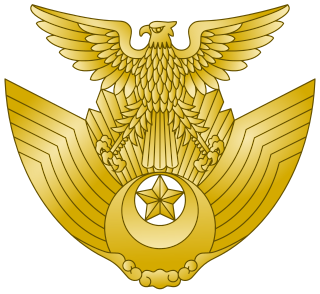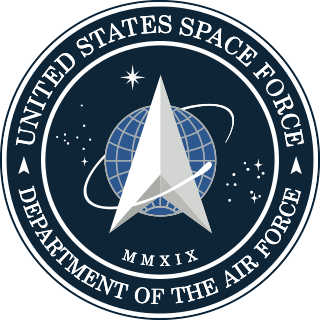Related Research Articles

The AIM-120 Advanced Medium-Range Air-to-Air Missile, or AMRAAM, is an American beyond-visual-range air-to-air missile (BVRAAM) capable of all-weather day-and-night operations. Designed with a 7-inch (180mm) diameter form-and-fit factor, and employing active transmit-receive radar guidance instead of semi-active receive-only radar guidance, it has the advantage of being a fire-and-forget weapon when compared to the previous generation Sparrow missiles. When an AMRAAM missile is launched, NATO pilots use the brevity code Fox Three.

The Semi-Automatic Ground Environment (SAGE) was a system of large computers and associated networking equipment that coordinated data from many radar sites and processed it to produce a single unified image of the airspace over a wide area. SAGE directed and controlled the NORAD response to a Soviet air attack, operating in this role from the late 1950s into the 1980s. Its enormous computers and huge displays remain a part of cold war lore, and a common prop in movies such as Dr. Strangelove and Colossus.

STS-4 was the fourth NASA Space Shuttle mission, and also the fourth for Space Shuttle Columbia. The mission launched on Sunday, 27 June 1982, and landed a week later on 4 July, Independence Day in the United States.

The LGM-118 Peacekeeper, first known as the MX or "Missile-X", was an encapsulated ICBM and the first U.S. ICBM to use a Cold Launch System. Although larger than the LGM-30 Minuteman, the MX was designed to fit inside existing hardened LGM-30 Minuteman ICBM silos as a silo-based ICBM and later as a mobile ICBM via the Peacekeeper Rail Garrison. The first 50 MX ICBMs were scheduled to be deployed and full initial operational capability achieved by the United States beginning and ending in 1986. The MX Peacekeeper was a MIRV missile platform that could carry up to 12 re-entry vehicles, each armed with a 300-kiloton W87 warhead in a Mk.21 reentry vehicle (RV). The first 50 missiles were deployed starting in 1986, after a long and contentious development program that traced its roots into the 1960s with the first generation ICBMs. Initial LGM-118A missile testing began 1971, with full-scale development starting in 1974. The first flight test occurred in 1983. This test also included the successful test deployment of six inert (unarmed) Re-entry vehicles, each hitting pre-planned targets. Initially, 100 MX ICBMs were planned to be built and deployed, but Congressional and budgetary concerns eliminated the final procurement.

The Cheyenne Mountain Complex is a military installation and defensive bunker located in unincorporated El Paso County, Colorado, next to the city of Colorado Springs, at the Cheyenne Mountain Air Force Station, which hosts the activities of several tenant units. Also located in Colorado Springs is Peterson Air Force Base, where the North American Aerospace Defense Command (NORAD) and United States Northern Command (USNORTHCOM) headquarters are located.

Cape Canaveral Air Force Station (CCAFS) is an installation of the United States Space Force's 45th Space Wing.

The Nike Hercules, initially designated SAM-A-25 and later MIM-14, was a surface-to-air missile (SAM) used by U.S. and NATO armed forces for medium- and high-altitude long-range air defense. It was normally armed with the W31 nuclear warhead, but could also be fitted with a conventional warhead for export use. Its warhead also allowed it to be used in a secondary surface-to-surface role, and the system also demonstrated its ability to hit other short-range missiles in flight.

The Northrop SM-62 Snark was an early-model intercontinental range ground-launched cruise missile that could carry a W39 thermonuclear warhead. The Snark was deployed by the United States Air Force's Strategic Air Command from 1958 through 1961. It represented an important step in weapons technology during the Cold War. The Snark took its name from the author Lewis Carroll's character the "snark".

Air Force Space Command (AFSPC) was a major command of the United States Air Force from September 1982 to December 2019. On 20 December 2019, concurrent with the signing of the National Defense Authorization Act for 2020, it was re-designated as the United States Space Force to stand up as a new sixth service branch of the United States Armed Forces responsible for space warfare.

Fireflash was the United Kingdom's first air-to-air guided missile to see service with the Royal Air Force. Constructed by Fairey Aviation, the missile utilised radar beam riding guidance. Fireflash had relatively limited performance and required the launching aircraft to approach the target from a limited angle astern.

The United States Army Space and Missile Defense Command (USASMDC) is an Army Service Component Command (ASCC) of the United States Army. The command was established in 1997. The current USASMDC commander is Lieutenant General Daniel L. Karbler with Senior Enlisted Advisor Command Sergeant Major Finis A. Dodson.

The Republic of China Air Force is the military aviation branch of the Republic of China Armed Forces. The ROCAF's primary mission is the defense of the airspace over and around Taiwan. Priorities of the ROCAF include the development of long range reconnaissance and surveillance networks, integrating C4ISTAR systems to increase battle effectiveness, procuring counterstrike weapons, next generation fighters, and hardening airfields and other facilities to survive a surprise attack.

The Space Innovation & Development Center (SIDC), formerly the Space Warfare Center (SWC), was a military unit of the United States Air Force. It was directly under Air Force Space Command (AFSPC) and resided at Schriever Air Force Base, Colorado. In 2013, AFSPC and ACC restructured the SIDC. Effective 1 April 2013, the SIDC transitioned into several Operating Locations at Schriever AFB under ACC's United States Air Force Warfare Center, headquartered at Nellis Air Force Base, NV.

The Japan Air Self-Defense Force, JASDF, also referred to as the Japanese Air Force, is the air warfare branch of the Japan Self-Defense Forces, responsible for the defense of Japanese airspace and for other aerospace operations. The JASDF carries out combat air patrols around Japan, while also maintaining a network of ground and air early-warning radar systems. The branch also has an aerobatic team known as Blue Impulse and has provided air transport in UN peacekeeping missions.

The Air Force Missile Development Center and its predecessors were Cold War units that conducted and supported numerous missile tests using facilities at Holloman Air Force Base, where the center was the host unit
The Western Range (WR) is the space launch range that supports the major launch head at Vandenberg Air Force Base. Managed by the 30th Space Wing, the WR extends from the West Coast of the United States to 90 degrees East longitude in the Indian Ocean where it meets the Eastern Range Operations involve military, government, and commercial interests. The WR has been operated by civilian contractors since its establishment, following the precedent of the Eastern Range. On 2003-10-01, InDyne Inc. took over the range contract from ITT Industries which had operated the range for the previous 44 years.

Aerospace Defense Command was a major command of the United States Air Force, responsible for continental air defense. It was activated in 1968 and disbanded in 1980. Its predecessor, Air Defense Command, was established in 1946, briefly inactivated in 1950, reactivated in 1951, and then redesignated Aerospace rather than Air in 1968. Its mission was to provide air defense of the Continental United States (CONUS). It directly controlled all active measures, and was tasked to coordinate all passive means of air defense.

The Air Armament Center (AAC) was an Air Force Materiel Command (AFMC) center at Eglin Air Force Base, Florida, responsible for development, acquisition, testing, and deployment of all air-delivered weapons for the U.S. Air Force. Weapon systems maintained by the center included the Advanced Medium Range Air-to-Air Missile, High-speed anti-radiation missile, HARM Targeting System, Joint Air-to-Surface Standoff Missile, Joint Direct Attack Munition, Miniature Air-Launched Decoy, Sensor Fuzed Weapon, and the Small Diameter Bomb. The Air Armament Center was inactivated as an AFMC center on July 18, 2012, and its functions merged into the former 96th Air Base Wing at Eglin AFB. The new organization was renamed as the 96th Test Wing the same day as a subordinate command of the Air Force Test Center at Edwards Air Force Base, California.

Boeing's Ground-to-Air Pilotless Aircraft (GAPA) was a short-range anti-aircraft missile (SAM) developed in the late 1940s by the US Army Air Force, and then the US Air Force after 1948. It was given the reference number SAM-A-1, the first Surface-to-Air Missile (SAM) in the 1947 tri-service designation system. By 1950 over 100 test rockets had been launched using a variety of configurations and power plants, with one launch in 1949 setting the altitude record for a ramjet powered vehicle at 59,000 ft (18,000 m).

The United States Space Force (USSF) is the space warfare service branch of the United States Armed Forces, and is one of the eight U.S. uniformed services. The sixth and youngest branch of the U.S. Armed Forces, it was the first branch of the military established since the formation of the independent U.S. Air Force in 1947. The direct antecedent of the Space Force, Air Force Space Command, was formed on 1 September 1982 with responsibility for space warfare operations. The National Defense Authorization Act for 2020 redesignated Air Force Space Command as the U.S. Space Force, and established it as an independent branch of the U.S. Armed Forces on 20 December 2019.
References
- ↑ Page, Joe. "New Missile Book, and Blue Fly" (PDF). Air Force Missileers. Association of Air Force Missileers. 19 (4). Archived from the original (PDF) on May 18, 2014. Retrieved 6 August 2016.